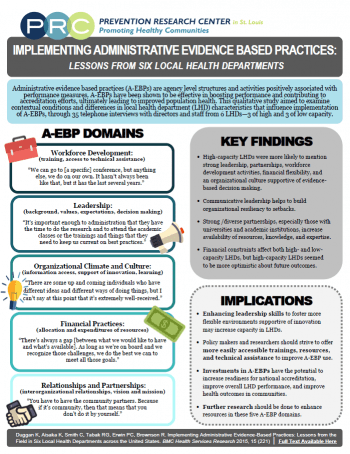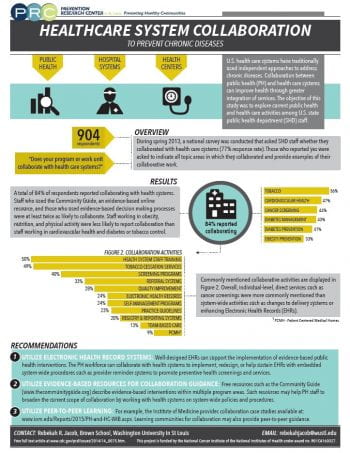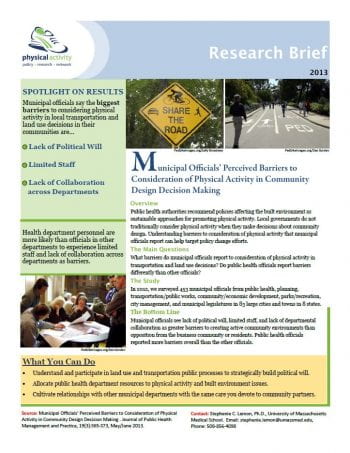View article briefs by topic, or scroll down and see them all below.
By Topic
- Assessing Capacity for Sustainability in Local Health Departments
- Capacity Building for Evidence-Based Decision Making: Scaling Up an Effective Training Approach
- Healthcare System Collaboration
- Implementing Administrative Evidence-Based Practices: Lessons from Six Local Health Departments
- The Importance of Scientific Resources Among Local Public Health Practitioners
- Training Needs & Supports
- Use of Academic Journals
- When Public Health Programs End
- Working Together to Enhance the Public Health Workforce
- Assessing Capacity for Sustainability in Local Health Departments
- Capacity Building For Evidence-Based Decision Making: Scaling Up An Effective Training Approach
- Implementing Administrative Evidence-Based Practices: Lessons From Six Local Health Departments
- The Importance Of Scientific Resources Among Local Public Health Practitioners
- Understanding Mis-Implementation In Public Health Practice
- Building Partnerships to Advance Physical Activity
- Diffusion of Complete Streets Policies
- Healthcare System Collaboration
- Lessons in Promoting Active Living
- Physical Activity in Community Design
- School Physical Education and Physical Activity Policies
- Training Needs & Supports
- Use of Academic Journals
- When Public Health Programs End
Working Together to Enhance the Public Health Workforce

Collaborative delivery of the EBPH training can strengthen the public health workforce, enhance academic-practice relationships, and promote populations-wide health and health equity.
Assessing Capacity for Sustainability
The Sustainability Framework, which includes 8 domains, is a useful tool for assessing public health program capacity for sustainability among local health departments.
Importance of Scientific Resources

There should be a clearer understanding of decision making patterns in Local Health Departments, particularly those that are based on scientific information.
Capacity Building for EBDM

This study tested local-level evidence-based decision making (EBDM) capacity-building efforts. It demonstrates the potential for improving EBDM capacity, while allowing for tailoring of strategies.
Implementing A-EBPS
Administrative evidence based practices (A-EBPs) have been shown to be effective in boosting performance and contributing to accreditation efforts, ultimately leading to improved population health.
When Programs End

Mis-implementation refers to ending effective programs or continuing ineffective programs. Understanding the reasons for mis-implementation can help practitioners use resources wisely.
Use of Academic Journals
Use of scientific evidence aids in creating the best health and economic return on investments. This brief describes information seeking practices among state health department chronic disease prevention staff.
Healthcare System Collaboration
Collaboration between public health (PH) and health care systems can improve health through greater integration of services. The objective of this study was to explore current public health and health care activities among U.S. state public health department (SHD) staff.
Training Needs and Supports
This brief describes training needs in evidence-based decision making (EBDM) at the national level based on competency gaps reported by state health department (SHD) and local health department (LHD) staff in four national surveys between 2008 – 2013.
Lessons in Promoting Active Living
Collaborative groups are integral in health promotion and disease prevention and use varied approaches to address complex health conditions within community settings. This brief explores collaborative efforts to promote active living.
School PE and Physical Activity Policies
Cardiorespiratory fitness, which has been associated with academic performance during childhood and adolescence, can be a benefit of school physical education (PE) programs. This brief explores the roles and strategies of state organizations.
Physical Activity in Community Design
Public health authorities recommend policies affecting the built environment as sustainable approaches for promoting physical activity. Understanding barriers to consideration of physical activity that municipal officials report can help target policy change efforts.
Diffusion of Complete Streets Policies
Complete Streets policies guide planning in communities by making the transportation system accommodating to all users—cars, pedestrians, bicyclists and those using public transportation. This brief explores which factors affect Complete Streets policy adoption.









